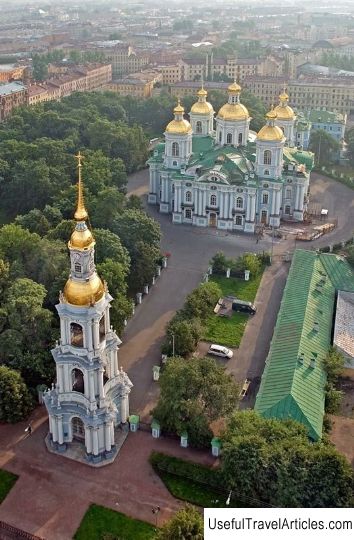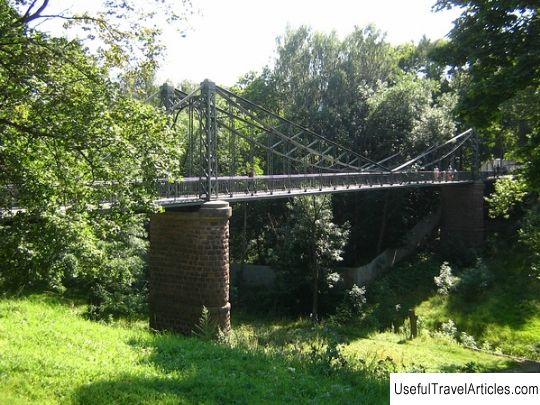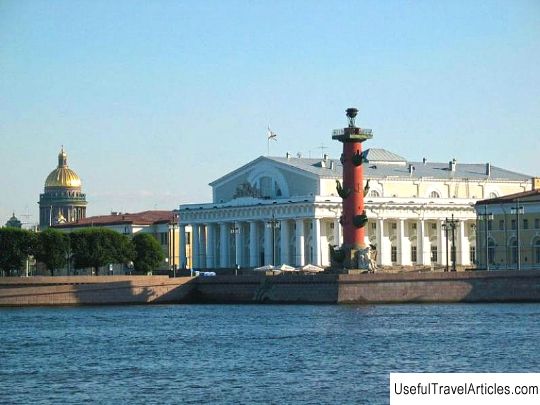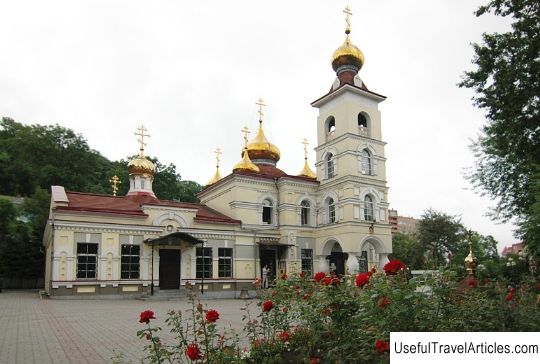Naval Nikolsky Cathedral description and photos - Russia - St. Petersburg: Kronstadt
Rating: 7,5/10 (100 votes) 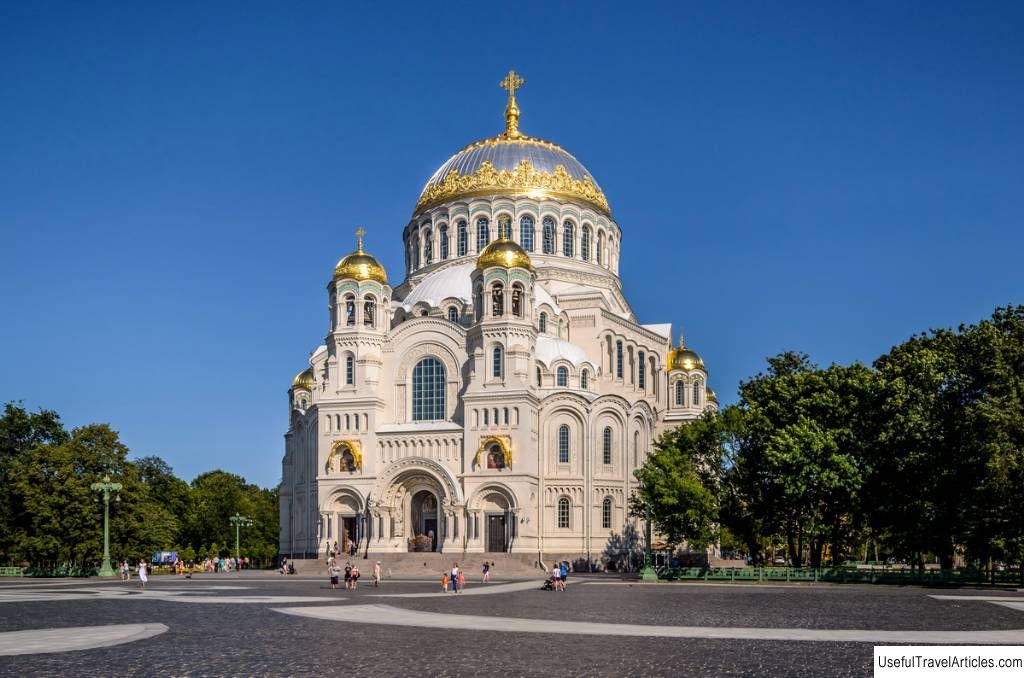
St. Nicholas Naval Cathedral description and photos - Russia - St. Petersburg: Kronstadt. Detailed information about the attraction. Description, photos and a map showing the nearest significant objects. Photo and descriptionOne of the main attractions of Kronstadt is the huge St. Nicholas Cathedral, visible from afar from the sea. This cathedral is a monument to all the dead sailors : it is both a functioning temple and a branch of the Naval Museum. History of Nikolsky CathedralIn the tradition of the Russian fleet It has long been accepted to build "naval" cathedrals : temples-lighthouses or simply temples, which mainly took care of the Russian fleet - at harbors, shipyards and naval barracks. They were traditionally built in the name of Vyatator Nicholas of Mirlikisky , who was considered the patron saint of sailors. This is due to several legends about the saint, who traveled a lot by sea during his life. Once, through his prayer, a sailor who fell from the mast and crashed was resurrected, once he stopped a storm - that is why everyone who has a sea voyage usually pray to him. Kronstadt, a large city in which thousands of sailors served, has long needed such a temple. In 1897, Vice-Admiral N. Kaznakov submitted a request to build a large cathedral in memory of all the sailors of Kronstadt who died in the line of duty. The collection of donations begins - however, for the construction of the temple, which was planned to be huge, they were not enough and the missing amount had to be replenished from the treasury. Contributed to the collection and further construction of the cathedral Alexander Zhelobovsky - the chief priest of the army and navy. He was very concerned about the arrangement of the regimental churches, with him more than seventy were built. The place for construction was chosen on the square, where old anchors and other rubbish used to be dumped, it was called so - Anchor. Officially, the foundation of the cathedral took place in 1903 in the presence of the royal family and during a solemn salute, and a park was laid out around the future church, in which the royal family planted several oaks. The temple was consecrated in 1913. The cathedral was built according to V. Kosyakov's project . He is an architect and engineer who designed many churches in the Byzantine style, but without the use of internal pillars, which are characteristic of traditional cross-domed structures. The temples of V. Kosyakov are exceptionally light and spacious inside. The cathedral in Kronstadt was already the second St. Nicholas Naval Cathedral of his authorship, before that, in 1902-1903, he designed the naval cathedral in Liepaja. Both here and there, the architect made extensive use of concrete floors - this was a new material for the early 20th century. Therefore, both cathedrals turned out to be exceptionally strong and resisted, despite the fact that they fell under the bombardment during the war. St. Nicholas Cathedral was conceived as another Russian version of St. Sophia's Cathedral in Constantinople, but the main theme of its decoration was marine . For example, its dome, far visible from the sea, was decorated with images of anchors: this is both a Christian symbol of salvation and the most common sea anchor. The dome was fifty-six meters high. images of fish were widely used in paintings and decor - here again Christian symbolism (and the fish is considered one of the symbols of Jesus Christ) combined with the sea. There are also jellyfish, ships and seaweed on the marble floor. The walls of the temple were decorated with majolica and mosaic icons. Inside the temple, fresco paintings and mosaics were also used, and in some places the frescoes specially copied the mosaic technique. The artist M. Vasiliev became the author of the murals in the temple. The iconostasis was carved from white marble, and the icons in it were also made using the mosaic technique. The cathedral was created as a memorial , along the entire perimeter it was decorated with marble white and black boards. On the white ones were written the names of the dead naval priests, and on the black ones - the dead naval officers and the deceased lower ranks were listed. The windows of the temple were decorated with stained glass - these were the largest stained glass windows in Russia at the beginning of the 20th century. The area of each of the stained glass windows was more than fifty meters. They were made by the Frank Brothers Northern Glass Industrial Society - the leader in glass production in pre-revolutionary Russia. The building was built using the latest technology. It had its own autonomous heating system, electricity, and even had its own vacuum cleaner for cleaning. Technical structures were connected to the temple by an underground tunnel. The temple remained operational for some time after the revolution, but in 1929 it was closed . In the winter of 1930, after an anti-religious meeting, the crosses were removed from the cathedral and the bells were thrown off. Most of the decoration was dismantled, murals and mosaics were painted over, and the temple itself was turned into a cinema. Maxim Gorky . During the war there was a artillery observation post . Several shells hit the building during the bombing. Under the dome there is an inscription “On March 2, 1943 at 12.20 the cathedral received its second baptism of fire. No harm done". Now in the temple you can see a trace on the floor a trace from an unexploded German shell - it has been preserved as a memorial sign. After the war, the building was restored, and since 1956 a theater was built here with a stage right in the altar . The space of the temple was partitioned off, the dome and the resulting second floor were in desolation. The revival of the templeSince the beginning of the XXI century, the transfer of the temple to the Church began. In 2005 the first service took place there, but the restoration continued until 2013, and in 2013 it was solemnly consecrated. Little was left of the original decoration of the temple, so it was restored, including plaques with the names of the victims. Now this temple is still a "sea" - it is considered the main temple of the Russian Navy and its interior is decorated with St. Andrew's flags, St. Andrew's flag is also used as an altar curtain. Among the shrines of the temple - particles of the relics of St. Nicholas of Mirlikisky, patron saint of sailors, St. naval commander Fyodor Ushakov, St. Sergius of Radonezh, St. Innocent of Irkutsk and others. Temple-Museum In 1974 the building housed a branch of the Naval Museum . The museum itself dates back to the time of Peter I, from his "model-camera", that is, a collection of models and drawings of various ships. In Soviet times, apart from the cruiser "Aurora", the museum owned the building of the Stock Exchange, the Chesme Church, etc. At that time the Nikolsky Cathedral displayed an exposition telling about the history of the Kronstadt fortress. Now the main exposition of the Naval Museum is located in St. Petersburg on Bolshaya Morskaya Street. But the Naval St. Nicholas Cathedral still maintains the status of a museum branch . On the left, you can see an exposition dedicated to the history of the temple and the clergy who took care of the Russian fleet. With the participation of the museum, social events are also held here - for example, in the refectory there are concerts, patriotic lectures for children and much more. There are guided tours of the temple (you can climb under the dome itself) and along the Anchor Square itself. In the park in front of the cathedral there is a Museum Artillery Site . It displays weapons from both the early and mid-20th century: armored firing points, deck and turret gun mounts, cannon barrels of the late 19th century, a side board from the cruiser Kirov. The sea and coastal artillery of the Kronstadt fortress, capable of firing at the most distant objects, played a huge role in the defense and liberation of Leningrad during the Great Patriotic War. Part of the presented artillery was manufactured directly in Kronstadt at the Kronstadt Naval Plant - for example, armored firing points (BOT). And, finally, not far from St. Nicholas Cathedral is another branch of this museum - memorial hall of Alexander Stepanovich Popov , the inventor of radio. The outstanding scientist worked and taught for many years in Kronstadt, at the Technical School of the Naval Department. The first radio workshop in Russia was created in Kronstadt. In the memorial hall you can see an exhibition of instruments created by A. Pavlov himself and his students - a ship's radio station, an X-ray machine, an electrophoretic machine, etc. And the building in which the hall is located is the Italian Palace. It was built during the reign of Peter I, and almost immediately was handed over to the fleet: at first there were naval institutions, and then the Naval Cadet Corps was transferred there. Such famous navigators as I. Kruzenshtern, M. Lazarev, F. Bellingshausen, Decembrists brothers Bestuzhev, V. Steingel and others studied here. John of Kronstadt and the Naval CathedralThe Cathedral is inextricably linked for us with the memory of Saint John of Kronstadt - a Kronstadt priest known for his righteous life and fiery sermons, who was canonized in 1990. He served in another cathedral of Kronstadt - in the not preserved St. Andrew's. Its restoration is now planned. But on the other hand, it was John of Kronstadt who conducted a prayer service for the foundation of the St. Nicholas Cathedral and was the first to donate for its construction: he donated 700 rubles and published a newspaper article calling for donations for the new church. One of the already modern shrines of St. Nicholas Cathedral is the trowel, which St. John made the symbolic laying of his first stone. In the left aisle of the cathedral you can see a small exhibition dedicated to the activities of St. John in Kronstadt.                         We also recommend reading House of Festivals and Congresses (Bregenzer Festspiele) description and photos - Austria: Bregenz Topic: Naval Nikolsky Cathedral description and photos - Russia - St. Petersburg: Kronstadt. |
